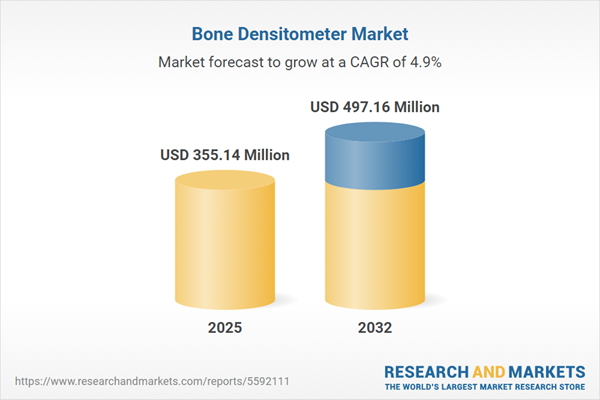Speak directly to the analyst to clarify any post sales queries you may have.
The bone densitometer market stands at the intersection of technological innovation and critical clinical demand, as healthcare organizations worldwide seek best-in-class diagnostic solutions to address the rising burden of osteoporosis and fracture risk. This report provides a focused, actionable resource for senior decision-makers navigating a rapidly evolving landscape in bone health diagnostics.
Market Snapshot: Bone Densitometer Market Size and Growth
The bone densitometer market grew from USD 338.07 million in 2024 to USD 355.14 million in 2025. It is expected to continue expanding at a compound annual growth rate (CAGR) of 4.93%, reaching USD 497.16 million by 2032.
Scope & Segmentation
This executive analysis covers the breadth of the global bone densitometer market, mapping its segments, technologies, and geographical spread. The study features a comprehensive breakdown including:
- Central DXA in diagnostic centers and hospitals, focusing on fracture risk and osteoporosis assessment.
- Quantitative Ultrasound across diagnostic facilities and hospital settings, enabling early screening and routine osteoporosis management.
- Peripheral DXA in clinics and rehabilitation centers, providing portable assessment tools for rapid risk identification.
- Regional Markets: Americas (North America, Latin America), Europe, the Middle East and Africa (Europe, Middle East, Africa), and Asia-Pacific (East Asia, Southeast Asia, South Asia, Oceania).
- Company Coverage: Profiling established technology leaders and innovative entrants—such as Hologic, GE HealthCare, Siemens Healthineers, DMS Group, Hitachi Aloka Medical, OsteoSys, Norland Medical Systems, Mindways Software, Medilink, and Sunlight Medical.
Key Takeaways for Senior Decision-Makers
- Advanced bone densitometry plays a central role in early osteoporosis detection and ongoing patient management, enabling more precise intervention strategies.
- Technological advances, including AI algorithms and portable systems, foster greater diagnostic accuracy and broader patient access, supporting outpatient clinics and rural outreach.
- Seamless integration with electronic health records is now a critical feature, facilitating efficient data sharing and supporting predictive analytics for risk management.
- Strategic industry partnerships help streamline device validation and accelerate the development of regulatory-compliant solutions, strengthening market positioning for leading vendors.
- Regional nuances, such as disparities in reimbursement policies, infrastructure availability, and demographic trends, significantly influence adoption rates and technology deployment approaches.
Tariff Impact on Bone Densitometer Equipment Procurement
Recent U.S. trade tariffs have reshaped procurement dynamics, driving up sourcing and production costs for bone densitometer equipment. In response, industry stakeholders have diversified supplier networks and pursued localized assembly to manage cost pressures. Leasing and service-based models are gaining traction, supporting more sustainable capital investments and uninterrupted access to essential diagnostic tools. Healthcare providers are adapting inventory management strategies to align with new supply chain realities.
Bone Densitometer Market: Research Methodology & Data Sources
Findings are grounded in a rigorous, multi-method approach. Primary data was obtained through structured interviews with clinicians, radiologists, and device engineers across hospital and diagnostic networks. Secondary research entailed systematic analysis of peer-reviewed literature, regulatory filings, and industry reports. Data triangulation and expert panel validation were employed to maintain accuracy, ensure consistency, and minimize bias across the study.
Why This Bone Densitometer Market Report Matters
- Enables informed strategic planning with a transparent view of emerging technology adoption and evolving regional policies.
- Provides actionable segmentation insights for targeted business development and partnership decisions.
- Supports procurement and investment strategies with a clear understanding of tariff and supply chain implications.
Primary Keyword: bone densitometer market
Secondary Keywords: osteoporosis diagnosis, fracture risk, quantitative ultrasound, musculoskeletal health, X-ray detectors
Conclusion
The bone densitometer market is advancing through technology-driven solutions and adaptive operational strategies. As AI and integrated analytics foster precision in osteoporosis diagnosis and fracture risk management, multidisciplinary collaboration and robust supply chain strategies will drive sustained opportunity across clinical environments.
Additional Product Information:
- Purchase of this report includes 1 year online access with quarterly updates.
- This report can be updated on request. Please contact our Customer Experience team using the Ask a Question widget on our website.
Table of Contents
3. Executive Summary
4. Market Overview
7. Cumulative Impact of Artificial Intelligence 2025
List of Figures
Samples

LOADING...
Companies Mentioned
The key companies profiled in this Bone Densitometer market report include:- Hologic, Inc.
- GE HealthCare Technologies Inc.
- Siemens Healthineers AG
- DMS Group, Inc.
- Hitachi Aloka Medical, Ltd.
- OsteoSys Co., Ltd.
- Norland Medical Systems, Inc.
- Mindways Software, Inc.
- Medilink Co., Ltd.
- Sunlight Medical Ltd.
Table Information
| Report Attribute | Details |
|---|---|
| No. of Pages | 192 |
| Published | October 2025 |
| Forecast Period | 2025 - 2032 |
| Estimated Market Value ( USD | $ 355.14 Million |
| Forecasted Market Value ( USD | $ 497.16 Million |
| Compound Annual Growth Rate | 4.9% |
| Regions Covered | Global |
| No. of Companies Mentioned | 11 |









